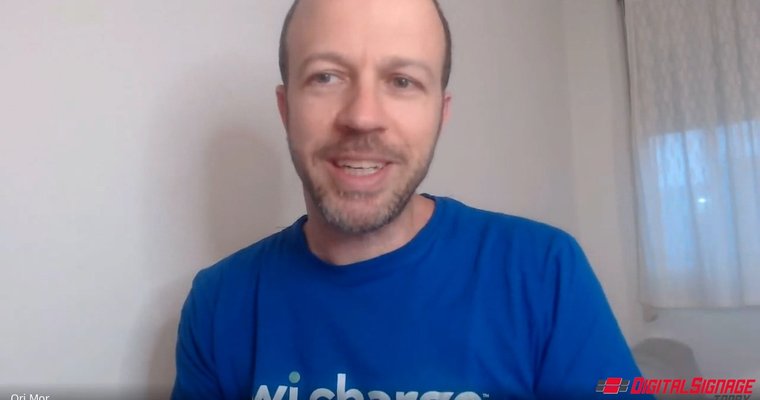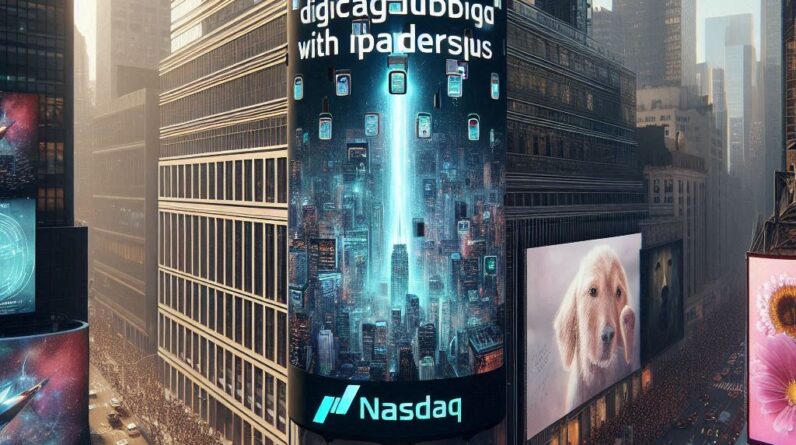
[ad_1]
Wi-Charge co-founder Ori Mor joins Digital Signage Today editor Daniel Brown via video link to discuss Wi-Charge wireless power technology and today’s announced launch of a 7-inch retail display — a Digital Signage Today exclusive.
 Image provided by Digital Signage Today.
Image provided by Digital Signage Today.
 |
Ori Mor is co-founder and Chief Business Officer at Wi-Charge. Image provided by Wi-Charge. |
Wi-Charge co-founder Ori Mor joined Digital Signage Today editor Daniel Brown via video link to announce the Israeli startup’s launch of a wirelessly-powered 7-inch retail display and to discuss the innovation and development behind wireless power, which Mor said is “efficient, safe, powerful.”
“I would say it’s the most efficient display in the world — that’s my claim,” Mor said. “I can’t prove that, but I know how we worked on every milliwatt.”
Interview has been edited for clarity and length. Key takeaways and full transcript are available below. |
Interview takeaways
Key points included:
- Previously available as a five-inch screen, customers indicated they wanted a larger screen space, which required additional engineering.
- Wi-Charge safety questions:
- The system uses natural infra-red frequency electromagnetic energy (essentially light) to power devices; this frequency is even safer than man-made frequencies.
- The system uses targeted beaming to precisely power devices; the beams turn off the moment they encounter an obstacle (a person or an object).
- The technology has major sustainability implications, Mor said, including preventing e-waste from many millions of used batteries going into landfills, along with waste like copper from discarded power cables.
- Wireless power also prevents expenses and ROI loss related to labor shortages, Mor explained, including compliance in battery replacement, and renovations related to running power cables in retail environments (a common expense among brick-and-mortar retailers).
- Thanks to its precision, Wi-Charge’s wireless power system is estimated to be more than 100 times more efficient than other wireless charging technologies.
- The system is now being used in retail and restaurant environments, including restaurants and grocery stores.
- One restaurant brand testing on-table displays found profit growth of $100 per week for each display used.
- The display includes a sensor that can help with data and analytics, such as aisle traffic and dwell time.
- To overcome technical and engineering challenges of the larger display, the team incorporated a second-generation charging receiver.
- Part of the core efficiency of the system is vertical integration of components, including firmware and OS.
- Wi-Charge is currently in use in Canada, U.S., Mexico, Brazil, Germany, Hungary, U.K., and Israel among other locations (including the Asia-Pacific region).
- The company’s strategy includes three major areas: the commercial, smart home and consumer spaces.
- Other products already on the market include a smart lock for the smart home and a wirelessly-powered electric toothbrush charger, and the company is working on additional ideas, including a wireless charging pad meeting rooms.
- As a battery expert, Mor also shared that battery-powered device life can be greatly extended by not overcharging devices, not using fast charging, and limiting charge between 20%-80% (similarly to points made by Rostyk Wynnyckyj).
Transcript
Daniel Brown: Okay, well, I am here with Ori Mor. And I’m so excited to talk because we have a lot of fresh news. Ori, do you want to introduce yourself to our audience real quick?
Ori Mor: Hey, yes, sure, Daniel. So, I’m Ori, one of the co-founders at Wi-Charge, the Chief Business Officer, excited to be here.
Brown: Wonderful. Thank you for joining me. I’m on the road this week with the Detroit Automate show. And I just had to make time because I was so excited, not just about the wireless power revolution. But it sounds like you guys have some exciting news as well.
Mor: Yep. I think it was a year back that we started to, we developed a five-inch display that is wirelessly powered five meters away five, maybe even 10 meters away, that can go into retail space, to advertise next to products, bringing digital marketing, digital engagement, next to products where it’s probably the most effective place to engage users. And we saw a lot of demand for that. But customers also wanted larger displays. So, we did what the customer wanted. And now we have a seven-inch.
Brown: You’ve got to listen to your customers. And just for folks who might be new to this, I think we chatted with you, gave a profile last Fall maybe about Wi-Charge, can you tell folks briefly what’s the Wi-Charge story? Why are you guys so revolutionary in this space?
Mor: Okay, so people probably know, have heard about wireless power. But what — when we think about wireless, when people hear about wireless power, they think of the charging pad where you have to place your phone on a specific bed for it to charge. It is indeed wireless, but it’s maybe contactless — it’s proximity charging, and being able to deliver power over, let’s say, an inch. What Wi-Charge does is we power devices from a distance of 30 feet. Okay, meaning, if you think of your phone, when you charge a phone today on the charging pad, it’s basically a docking station, meaning when Daniel wants to charge his phone, he needs to think: Oh, I now need to charge my phone. So, I’ll place it on a charging pad. And the charging pad itself is connected with a wire. When people, if you’d ask people what wireless power really is, what they really should be, they will tell you: Oh, like Wi-Fi for power. And that’s what Wi-Charge does, you can place your device anywhere, the transmitter would find it and would charge it from 10 meters away.
Brown: That’s amazing. And so it sounds like one of the first use cases that you’re doing, like you mentioned, what is it, over 80% of purchases happen at the point of decision in a brick and mortar store. And you found a way to install these screens without having to worry about putting in all of this troublesome wires and digging into walls and so forth. You can just set it right up it sounds like.
Mor: Exactly — how come brands are paying $300 billion every year for digital advertising, but where 80 percent of the buying takes place, there is no almost no digital advertising? Does it make sense? This is where people engage with real goods. This is where they are with their credit card already. Why not engage them? So, it turns out it’s a hassle to bring power to the shelf. Wires are prohibited in retail, batteries would run out way too often, and ESG as well, but as you probably know, retail me and network is starting to generate a lot of traction with sophisticated big retailers and with other retailers and the missing piece is: How can we power devices at the edge of the shelf?
Brown: And you just spoke one of the magic words — we launched, I can’t believe we launched it in the past year, a section on sustainability which has been very popular. It’s a huge topic. And I was really surprised and happy to see — it sounds like wireless power is impacting sustainability and preventing batteries from going to the landfill. Is that accurate?
Mor:
Yes, what we can do — let’s take I’ll take a big retailer without adding names, not because it’s not public, but simply for the sake of not mentioning names. But if a big retailer, a prominent retailer decides to adopt ESLs, and ESL is only the price labels, okay? And you have hundreds, 1000s of these in a single store. Even if they last on a battery five years, and you have so many stores, you will have to deploy, to grow close to 100 million batteries every year. That’s, that’s prohibited, right? We don’t want that to happen. So, there is a transition that even the ESLs themselves will be rechargeable ESLs. But guess what? Someone needs to recharge the rechargeables, and once you have a rechargeable ESL that has access to power, suddenly the price tags can add — Did he know that E-ink can do animation? E-ink can actually do animation. But if E-ink would do animation on ESLs, the battery life would would be months instead of years. You can’t do that. If you want to advertise or if you want to promote products with different pricing at the beginning of the day, at the end of the day, for perisheables, for example, or if you have a special promotion for Saturday night something or for football, Monday football, you can’t update today because of the concern of — on battery life. With wireless power, you get rid of the batteries, and you have excess power to do whatever you want. That’s the magic of wireless power.
Brown: And we have to say for — the Americans are very superstitious, I’m going to put my nation under the bus, we’re superstitious about technology, this is totally safe. Like this is not going to get people the 5G, the crazy conspiracies — like this is just wireless power, it’s not going to hit you and hurt you.
Mor: Yes, I would say that they are concerned from a good reason. When you transmit something over the air, people are rightfully to ask: How does it impact me? So, we have two answers. One, our technology is already FDA approved. The second answer is that we’re using infrared, which is the most benign part of the spectrum, it’s not a man-made radiation look like RF microwave, so it’s more, so it’s safer than that. And also, we direct our power, the transmitter sends at the directional beam to the receiver, meaning if you’re outside the beam, even a millimeter away from the beam, you’re not exposed to anything. And when you pass the — when you’re interrupting between the transmitter and the receiver, the beam collapses very fast. So, you’re not getting exposed to light. So, it’s light and you’re not getting exposed. So, nothing to be concerned about.
Brown: That’s powerful. And it sounds like it’s much more efficient than one would imagine as well, because if it’s beaming power in every direction, that’s very wasteful, but you’re precisely going straight to the device.
Mor: That’s the magic. Yes. This is why we can deliver the power efficiencies, and I’m not exaggerating, 100 times and probably more than 100 times better than any other distance charging technologies. And it’s efficient, safe and powerful.
Brown: Are you experimenting, I’m curious, with longer and longer range transmissions? And are we heading for a future where I can just walk down the street, I can go to a restaurant, and my phone is charging in my pocket while I’m eating.
Mor: So, no in your pocket, it won’t happen. Because this is against — if I can penetrate your pocket, I can penetrate your body. And you don’t want me to penetrate your body. The technology is when you take out your phone and you will place it on the table or place it, or walk with it. The transmitter will find it, and as long as there is line of sight between the transmitter and the client device, it will charge it. But not when it’s hidden. If it’s hidden, it means that — it would have been great if it can charge in your pocket. But at the same time, you wouldn’t want it.
Brown: Perfect. I love that. And I’m curious too. It sounds like — I’m thinking, I used to work in restaurants right? And I’m thinking this would be a big game changer for point of sale just for the restaurant industry, it sounds like — boosting sales suggestive sales, margarita of the day, you name it. Have you guys worked in the restaurant industry at all?
Mor: We’re already installed in a few restaurants. And we have even a partner that did a pilot for point of purchase displays, for table displays. And he was able to prove that with displays you can drive additional revenues of roughly $100 per week per display. This is an amazing number. I think we’ll see that, more and more, happening. If you can create — you have your customers, they are sitting at your dining room. They came there to eat your food. And they’re already willing to pay. If you’re smart, and you can offer them not spam them, and if you can offer them something that they will be thanking you. You can probably add a dessert, add some beer, something that will enhance their experience and at the same time for the retailer, for the restaurant owners, you will see more revenues. So definitely.
Brown: That’s huge. Well, I’d imagined the big screen, the larger screen would come into handy for that. Was it a big technical challenge to engineer this larger screen space?
Mor: Yes, it’s we have here display I don’t know if you saw that, so that’s the display. Okay, that’s, that’s the seven inch. It has our receiver here on top, actually the receiver is even smaller than that.
Brown: Oh, so the little black bar is for the power receiver right there.
Mor: Yes, exactly. And here we have a sensor that actually measures aisle traffic and analytics, and so it provides you with basically what’s needed to do if you want to do the same — Let’s say you want to engage, I’ll go back to the technical question in a second. But let’s say you want to engage customers. Okay? How do you know that the content actually works? How do you know that people are viewing? What’s the dwell time, can I do AB testing? I want to, at the end of the day, I want to close the loop on the point of sale, knowing that the content actually delivers ROI. So, with the with the engagement analytics, we can close the loop. Regarding the technical challenge, yes, it’s high, it’s a higher power display. What we did is we incorporated this next generation, not the next now, it’s not next-gen — a second generation receiver that is smaller but higher power, we did a redesign, a slight redesign, for the hardware and firmware, so we, we were able to optimize the power consumption, I think it’s the, I would say it’s the most efficient display in the world. That’s my claim. I haven’t proven that. But I know how hard we worked on every milliwatt there. And we’re already working — that’s a long answer!
Brown: It’s okay, we love long answers here.
Mor: Okay, and we’re already working on the next generation of the firmware that is supposed to be even probably 30% even more efficient, with a dedicated MCO that is more optimized to driving video than what we’re using today.
Brown: So you’ve got your own, it almost sounds like a fully integrated vertical, where you have your own software team even doing yourself or engineering. So it’s custom. It’s boutique.
Mor: Yes, yes, it’s fully vertically integrated. We know what wireless power is. We know where the limitations are, where the capabilities are. And we stripped down, when you’re taking an existing — let’s call it an Android device. It has so many additional features and layers, that we don’t need to drive advertising or promotion at the point of purchase, but they consume unnecessary power. So, we basically had our own operating system. And we build our own firmware on top of the of the dedicated hardware that we developed.
Brown: So, if you were trying to use Windows or something, it would be very wasteful. But since you’re using your own, it’s more efficient?
Mor: Yes.
Brown: That’s brilliant. I love that. Well, and I don’t want you to give away all of your secrets, right? But I’m curious to know, how widespread Are you now around the world? How long before this becomes the normal go to power solution, do you think, for wireless power?
Mor: That’s a good question. It’s, I can tell you that we are. We’re installed already. We’re in the early stages. Okay. It’s not that we’re widely deployed, but we’ve already installed in Canada, in the U.S. in Mexico, in Brazil, in Germany, in Hungary, in, in the U.K. In Israel, of course. And probably a few other locations that that I forgot, including Asia Pacific. When would it be widely deployed? I believe that in the next two years, we will launch in three different baskets. One is the commercial space. One is the smartphone space. And one is the consumer space. The last one will be the consumer. What we believe will happen is that once people will see you know, people were waiting for wireless power for quite some time. Is it a myth, does it exist? Now we have more and more installation. Now people see hey, listen, this thing works. It’s in commercial space. It’s in public space. It works, powers devices from few meters away. Why don’t they add this capability to my devices? So, I think the best way to look at it is like COVID — only a few locations but then it suddenly spreads exponentially. That’s probably how it grows.
Brown: So, it sounds like from what you’re saying this will eventually be in the smart home, this is going to be in my house, making my life easier.
Mor: Yes, we are already selling — a partner of us that does smart locks is already offering smart locks that never run out of power with excellent connectivity with superior security to smart home.
Brown: I’m curious one of the other sustainability questions I remember working in IT and you know, wasting 1000s of feet of cable that just went into trash every year, you know, during refreshes. And it sounds like maybe this is a way to take tons and tons and tons of wasted copper and plastic lines and Ethernet cables, well not Ethernet but power, and maybe reduce that waste. Would you say that’s fair?
Mor: I think, yes. The, the short answer is yes, it does. There are other advantages — when you charge devices, today, when we charge devices, we try to charge them as fast as possible. It ends up by shortening battery life, because there is a lot of stress there. If you keep a battery between 20% to 80%, you can extend the battery life by a factor of five. So, you would use copper, you extend rechargeable battery life. And there are devices like — think of faucets, in shopping centers, in airports, they are battery-operated, you can get rid of all these batteries and replace them with super capacitors that last, that are eco-friendly. It’s an electronic component. It’s eco-friendly, it will last that 30 years. And with this in with one second of charging from this device, one second of charging, you can serve 70 people, instead of all the batteries that are being wasted on these devices.
Brown: Well, it sounds like one of the other things this might impact is also sort of the compliance with replacements. And there’s such a labor crisis right now in many American industries, I know, we’re even, were getting the staffing even replaced these batteries is a pain. And it sounds like this is a way to say well, you don’t need to replace those batteries.
Mor: An airport not far away from you, okay, really close to you, approached Wi-Charge and said: Can you charge all our devices in the bathrooms? And when we ask why he said: (a) when the battery dies, we only know about a faucet that is not working or a valve that is not working when someone complains. That’s one thing. Then, if you need if we need to replace 1000 batteries, we need to order 10,000 batteries because 9,000 are disappearing on the way. Okay, so the labor is not there, when the labor is there, they like the batteries too much. And yes, and you get, and you understand that there is a problem only after someone complains.
Brown: So it’s a customer experience thing, it’s a customer service thing now?
Mor: It’s a customer experience, it’s a customer service — and once you have the extra power, you can suddenly say: Hey, this this, the sink is clogged, because you have extra power to the to transmit information and to measure stuff. Okay, and you can you know, you can do remote maintenance with a click of a button without sending people. The level of automation can be much more, can be much higher.
Brown: This is powerful. Well and like you said earlier to with the screens, you’ve deployed. There’s also this omnichannel metrics, the analytics where lots and lots of stores need to know and understand dwell, time traffic, where should we restructure the store and put these products out in the front and so forth. I’m curious, I don’t want you to screw up yourself. I don’t want to give away any secrets. But it sounds like even more big things might come down the pike. Anything we should watch for from you guys in the coming year or two.
Mor: It’s right now we’re focused. We’re a small company, we need to focus, we need to execute what we do well, but we have additional toys for smart home that we were playing. By the way there are two that we announced at CES. One was this cool electric toothbrush charger that everyone wants because it gets rid of the cord in the bathroom — no electricity, no hazards from high voltage, high voltage electricity near water and no messy cords in your bathroom. So that’s one thing we’re toying with. The other thing that we’re toying with is this one, is the charging pad for meeting rooms. We will have a charging pad but that is cordless. And there are other gadgets that are in the bake. At some point in time, we would go back and allow people to license — when the technology gets to a certain stage, we can license it, like being the Intel inside. You use it, take the chip, do whatever you want. We will provide you wireless power. At the beginning with no ceiling, then serve everyone and let them enjoy.
Daniel Brown is the editor of Digital Signage Today. He is an accomplished technology writer whose experience includes creating knowledge base content for a major university’s computing services department. His previous experience also includes IT project management, technical support and education. He can usually be found in a coffee shop near a large pile of books.
[ad_2]
Source link






